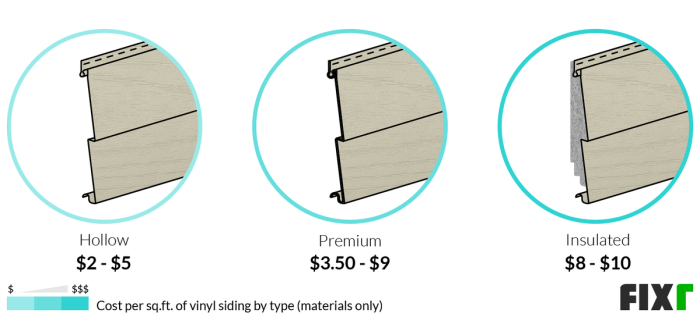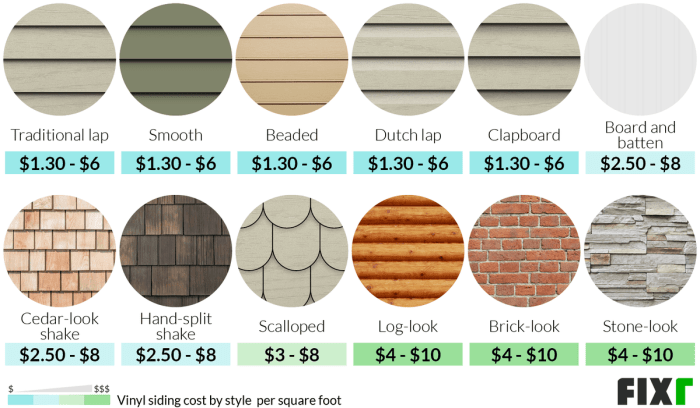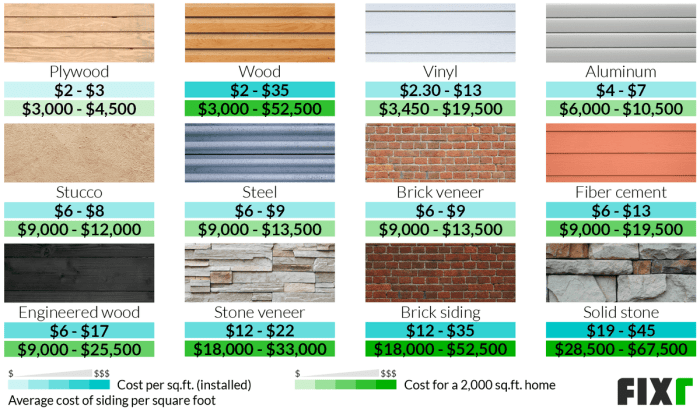Delving into the realm of vinyl siding cost per square foot in 2025 unveils a multifaceted landscape shaped by various factors. From market trends to technological advancements, the pricing dynamics of vinyl siding are intricately intertwined with the evolving facets of the industry.
As we navigate through the details, a clearer picture emerges of how environmental regulations, material prices, and labor costs play pivotal roles in determining the cost per square foot of vinyl siding in the upcoming year.
Factors influencing vinyl siding cost per square foot in 2025

In 2025, several key factors will influence the cost of vinyl siding per square foot. These factors include market trends, material prices, labor costs, and environmental regulations or innovations.
Market Trends
Market trends play a significant role in determining the cost of vinyl siding. Fluctuations in demand, consumer preferences, and competition among manufacturers can impact prices. For example, if there is a high demand for vinyl siding due to its durability and low maintenance, prices may increase.
On the other hand, if there is a surplus of vinyl siding in the market, prices may decrease to stimulate sales.
Material Prices
The cost of raw materials used to manufacture vinyl siding directly affects the pricing per square foot. Factors such as the price of PVC resin, additives, and color pigments can influence overall costs. Fluctuations in oil prices, as PVC is derived from petroleum, can also impact material prices and, consequently, the cost of vinyl siding.
Labor Costs
Labor costs are another crucial factor in determining the overall cost of vinyl siding installation. Skilled labor for siding installation may come at a premium, especially if there is high demand for construction services. Additionally, factors like location, project complexity, and labor availability can influence labor costs and, consequently, the final price per square foot.
Environmental Regulations and Innovations
Environmental regulations and innovations in the vinyl siding industry can also impact costs. Stricter regulations on manufacturing processes or waste disposal may lead to increased production costs, which could be passed on to consumers. Conversely, innovations in eco-friendly materials or energy-efficient siding options may provide cost-saving alternatives for consumers looking to reduce their environmental impact.
Comparison of vinyl siding costs with other siding materials
Vinyl siding costs can vary significantly compared to other siding materials such as wood, fiber cement, or metal. Let's explore the cost-effectiveness, advantages, and disadvantages of vinyl siding in comparison to these alternatives.
Cost per Square Foot Comparison
When comparing the cost per square foot, vinyl siding is generally more affordable than wood or fiber cement siding. Metal siding may be comparable in cost to vinyl, depending on the specific type of metal used. Vinyl siding is often chosen for its cost-effectiveness, making it a popular choice for homeowners on a budget.
Advantages and Disadvantages of Vinyl Siding
Advantages of vinyl siding include its lower initial cost, minimal maintenance requirements, and wide range of colors and styles available. However, vinyl siding may not have the same aesthetic appeal as wood or fiber cement siding. It is also less durable and may be prone to damage from extreme weather conditions.
Long-Term Expenses and Maintenance Costs
While vinyl siding may be cheaper upfront, it is important to consider long-term expenses and maintenance costs. Wood siding may require more maintenance over time, leading to higher costs in the long run. Fiber cement siding is durable but may require repainting or repairs, adding to maintenance expenses.
Metal siding can be cost-effective in the long term due to its durability and low maintenance requirements.
Regional variations in vinyl siding pricing
When it comes to vinyl siding pricing, the cost per square foot can vary significantly depending on the region. Various factors unique to each area can influence the overall pricing, making it essential to consider these regional variations.
Impact of Climate on Pricing
Regions with extreme weather conditions, such as areas prone to hurricanes, heavy rain, or snow, may require higher quality vinyl siding to withstand these elements. This can lead to higher prices per square foot compared to regions with milder climates.
Regulations and Codes
Local building codes and regulations can also affect the cost of vinyl siding. Some areas may have specific requirements for siding materials, colors, or installation methods, which can impact pricing. Compliance with these regulations may result in additional expenses.
Local Labor Rates
Labor rates vary from region to region, affecting the overall cost of vinyl siding installation. Areas with higher labor costs will likely have higher prices per square foot. Additionally, the availability of skilled labor in a particular region can also impact pricing.
Material Availability
The availability of vinyl siding materials in a specific region can influence pricing. Remote areas or regions with limited suppliers may have higher prices due to transportation costs. Conversely, areas with a higher concentration of suppliers may offer more competitive pricing.
Innovations in vinyl siding technology affecting pricing

Vinyl siding technology has seen significant advancements in recent years, leading to changes in pricing based on the features, durability, and energy efficiency enhancements that these innovations bring about.
Enhanced Durability and Longevity
One of the key factors influencing vinyl siding pricing is the improved durability of newer products. Manufacturers have developed vinyl siding options that are more resistant to cracking, fading, and warping, making them a more long-lasting investment for homeowners. The increased lifespan of these advanced products can drive up the cost per square foot due to the higher quality materials and manufacturing processes involved.
Energy Efficiency Features
Another important aspect of modern vinyl siding technology is the integration of energy-efficient features. Some vinyl siding products now come with insulation properties that can help improve a home's energy efficiency by reducing heat loss. While these energy-saving benefits can lead to long-term cost savings for homeowners, the initial price of vinyl siding with these features may be higher compared to traditional options.
Aesthetic Enhancements
Advancements in vinyl siding technology have also allowed for a wider range of aesthetic options for consumers. From improved color retention to better texture replication that mimics the look of real wood, these aesthetic enhancements can impact pricing based on the complexity of manufacturing processes and the quality of the final product.
Homeowners looking for customized or premium vinyl siding options may expect to pay more per square foot for these innovative features.
Smart Siding Solutions
Innovations in vinyl siding technology have also led to the development of smart siding solutions that incorporate technology for enhanced performance. From options that resist moisture damage to those that can withstand extreme weather conditions, these smart siding solutions may come at a premium price point due to the advanced materials and engineering required.
Concluding Remarks

In conclusion, the realm of vinyl siding cost per square foot in 2025 is a dynamic space where innovation meets necessity. Understanding the factors influencing pricing, comparing it with other materials, considering regional variations, and embracing technological advancements are key to making informed decisions in the realm of siding solutions.
Helpful Answers
What are the key factors influencing vinyl siding cost per square foot in 2025?
The key factors include market trends, material prices, labor costs, and environmental regulations.
How does vinyl siding cost per square foot compare to other siding materials like wood or fiber cement?
Vinyl siding is often more cost-effective than materials like wood or fiber cement, considering long-term expenses and maintenance costs.
How do regional variations impact vinyl siding pricing?
Regional factors such as climate, regulations, labor rates, and material availability can influence the cost of vinyl siding per square foot across different areas.
What technological innovations are affecting vinyl siding pricing in 2025?
Advancements in technology are impacting costs through features, durability improvements, and energy efficiency enhancements in vinyl siding products.

















